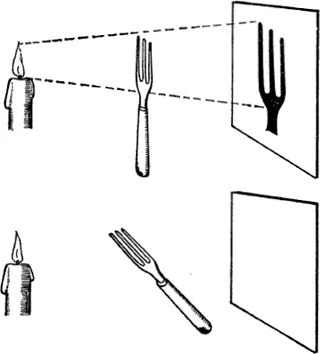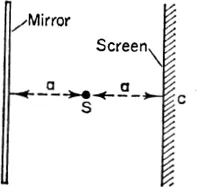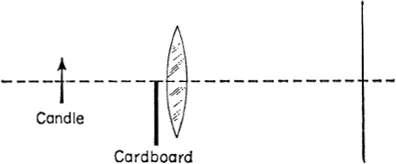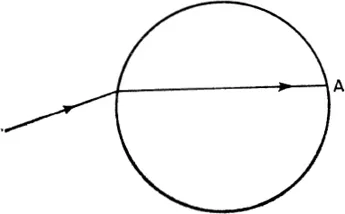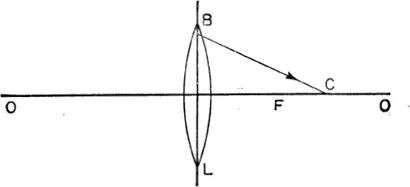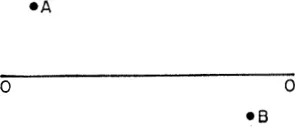![]()
XI. Optics
288. A fork is illuminated by a candle and casts a shadow on the wall. When the fork is in a vertical position, the shadow reproduces the shape of the fork’s prongs distinctly, but when it is in a horizontal position the shadow is blurred and the prongs are not visible (Fig. 144). Why?
289. A screen is placed at distance a from a point source of light S. How will the illumination at the centre of the screen be altered if a plane mirror be placed on the other side of the source at the same distance a from it (Fig. 145)?
290. What should be the least size of a plane mirror for a man to be able to see himself at full length when standing in front of it?
291. A photographer with an extending camera takes a photograph of a man, and then photographs the clouds floating across the sky. Should he increase or decrease the camera’s extension?
292. A point of light lies between two plane mirrors which are parallel to each other. How many images of the point will be obtained in the mirrors?
293. A point of light A lies between two plane mirrors which are arranged at right angles to each other. How many images of the point can be seen in the mirrors?
294. Arrange two mirrors so that, whatever the angle of incidence, the incident ray and the resulting ray reflected from the two mirrors should be parallel to one another.
295. Arrange three mirrors so that they all intersect and so that, whatever the angle of incidence, the incident ray and the resulting ray reflected from the three mirrors should be parallel to one another.
296. In what medium can rays of light be curved?
297. An eclipse of the sun is being observed. At one moment the edge of the sun, the edge of the moon and the observer’s eye are in the same straight line. How soon after this will the observer first see the sun’s rays?
298. When the sun rises it often appears to be flattened, Why?
299. A man A stands to one side of a mirror (Fig. 146); a second man B approaches the mirror along the line perpendicular to it which passes through its centre. At what distance from the mirror will B be at the moment when A and B see each other in the mirror?
300. A small square mirror S lies on a table. Of what shape will the sun’s reflection from this mirror be on a screen E which is positioned in a vertical plane and at a reasonable distance from the mirror (Fig. 147)?
301. Of what shape should the front surface be of the cornea of an imaginary animal which could see distant objects equally well in the air and under water without any supplementary accommodation?
302. An image of a candle is obtained on a screen with the aid of a double convex lens. How will this image be altered if the lens be half covered by a piece of cardboard (Fig. 148)?
303. A double convex lens of focal length f lies between a source of light and a screen. The distance between the source oi light and the screen is less than 4f. It is known that in these conditions it is not possible to obtain an image of the source on the screen, whatever the position of the lens. How can an image of the source be obtained on the screen with quite simple means and without moving either lens or screen?
304. Is it possible in certain circumstances to obtain a real image in the air with the aid of a double concave glass lens?
305. A ray of light falls on to a transparent homogeneous sphere and passes into it. After passing through the inside of the sphere it reaches the sphere-air surface at A (Fig. 149). Can total internal reflection take place at this point?
306. In Fig. 150 is depicted the path of a ray of light BC after refraction in a double convex lens L of principal focus F and of principal axis OO. Find by construction the path of this ray before reaching the lens.
307. With the help of a lens of principal axis OO an image B is obtained of point A (Fig. 151). Where is the lens placed, of what kind is it and where are its foci?
308. How should two converging lenses be placed so that a parallel beam should become parallel once more after passing through both lenses?
309. Where should a point source of light lie along the principal axis of a converging lens so that it is impossible to see the source and its image simultaneously from any point?
310. A disk whose plane surfaces are parallel is cut as shown in Fig. 152a; then the lenses so obtained are moved apart. What will happen to a beam of parallel rays falling on to the resulting system:
(a) from the side of the converging lens (Fig. 152b), (b) from the side of the diverging lens (Fig. 152c)?
Consider the cases when the distance between the lenses is less than the focal length and when it is greater than the focal length.
311. A broad beam of parallel rays of light, consisting of rays of two colours of the spectrum is dispersed in a liquid. How c...

